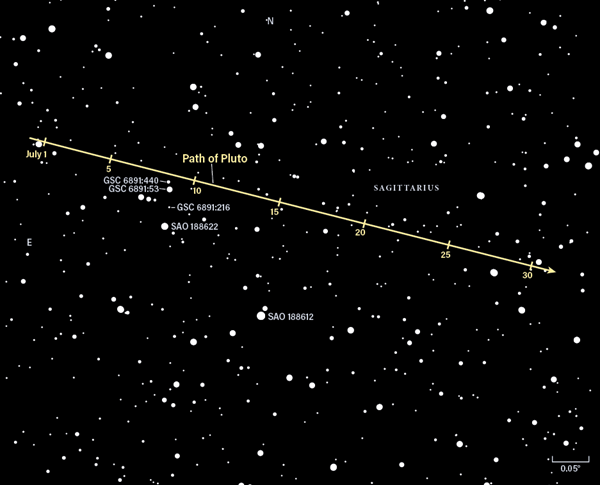Saturday, July 17
First Quarter Moon occurs at 6:11 A.M. EDT.
The dwarf planet Pluto reaches opposition at 7 P.M. EDT tonight. You’ll find it in the south, rising around 8 P.M. local time amid the stars of Sagittarius the Archer. Give it an hour or two to climb out of the turbulent air near the ground a bit, as well as for the sky to grow dark enough to search out the tiny, magnitude 14.3 world. You’ll need at least an 8-inch telescope to spot Pluto as it slowly moves westward against the background stars. Checking back every hour or two should reveal its subtle motion. There are no bright stars in the vicinity; you can use the star chart above to find Pluto anytime this month.
Unfortunately, the bright First Quarter Moon tonight will make tracking Pluto a bit more challenging. Try to find an observing site with minimal to no light pollution to improve your chances, or wait to search until later this month or early next, when the Moon is no longer so bright.
Nearby, asteroid 6 Hebe also reaches opposition at 7 P.M. EDT, located in Aquila the Eagle. You should have less trouble finding the brighter magnitude 8.5 world near the border of Aquila and Sagittarius, about 3.5° south of 5th-magnitude Kappa (κ) Aquilae.
Sunrise: 5:46 A.M.
Sunset: 8:26 P.M.
Moonrise: 1:43 P.M.
Moonset: 12:29 A.M.
Moon Phase: Waxing gibbous (53%)
Sunday, July 18
Asteroid 2 Pallas is stationary in the constellation Pisces at 4 P.M. EDT today. The second asteroid ever discovered, it is the third-largest asteroid in the Main Belt and orbits the Sun once every 4.6 years.
Tonight, Pallas sits north of the Circlet in Pisces, just at the border between Pisces as Pegasus. The magnitude 10 world will need binoculars or, depending on your sky conditions, a small telescope to easily find. It’s located about 2.3° east-northeast of 4th-magnitude Theta (θ) Piscium, and is roughly even with the star above the horizon as they rise late tonight around 10 P.M. local time. You’ll want to let them climb higher for the best views, which will occur after midnight and into the early hours of tomorrow morning.
Sunrise: 5:47 A.M.
Sunset: 8:25 P.M.
Moonrise: 2:55 P.M.
Moonset: 12:57 A.M.
Moon Phase: Waxing gibbous (65%)
Monday, July 19
At 12 A.M. EDT this morning, just as the date changes from July 18 to 19 on the East Coast of the U.S., Jupiter’s moon Io is poised to transit the planet’s large disk. The dark blot of the tiny moon’s shadow is already one-third of the way across the planet, and will take another hour and a half to reach the western edge. Meanwhile, Io itself takes about 2 hours and 20 minutes to cross the face of Jupiter, which stretches 47″ across. Even a relatively small scope should show the sequence beautifully, thanks to Jupiter’s large size and bright magnitude –2.8 glow.
Jupiter’s Great Red Spot, an ongoing storm roughly the size of Earth, is also visible on the planet’s disk for much of the transit, slightly ahead (west) of Io’s shadow. Look for other cloud features and how they change as the planet turns — its fast rotation rate of just under 10 hours means motion is visible over just a short period of time.
All three remaining Galilean moons sit west of Jupiter: from west to east are Europa, Ganymede, and Callisto.
Sunrise: 5:47 A.M.
Sunset: 8:25 P.M.
Moonrise: 4:10 P.M.
Moonset: 1:30 A.M.
Moon Phase: Waxing gibbous (75%)
Tuesday, July 20
Mercury has been growing brighter over the past two weeks; but even so, its visibility is waning as its elongation shrinks. If you’re up before the Sun, you may spot the small planet shining brightly at magnitude –1 about 45 minutes before sunrise, when it’s just 3° high and rising between the two figures of Gemini the Twins. About 4.5° above Mercury shines Mebsuta, Gemini’s 3rd-magnitude epsilon star. 13° to this star’s northeast (lower left on the sky) is Castor, one of the Twins’ heads. Pollux will clear the horizon about 10 minutes later. The Sun is hot on both stars’ heels.
This is one of your last chances to catch Mercury in July; over the next week, it will continue to sink toward the Sun, reaching superior conjunction next month.
Sunrise: 5:48 A.M.
Sunset: 8:24 P.M.
Moonrise: 5:25 P.M.
Moonset: 2:08 A.M.
Moon Phase: Waxing gibbous (85%)
Wednesday, July 21
The Moon reaches perigee at 6:24 A.M. EDT, when it will sit 226,503 miles (364,521 kilometers) from Earth. Perigee is the closest point to Earth in the Moon’s not-quite-circular orbit; the farthest point is called apogee.
Venus passes 1.2° north of Regulus, Leo the Lion’s alpha star, at 3 P.M. EDT. By half an hour after sunset, both are visible in the western sky. The planet — blazing a bright magnitude –3.9 — is now 1.1° northeast of the 1st-magnitude star, far outshining it. Meanwhile, Mars — a much dimmer magnitude 1.8 — sits farther west along the ecliptic, nearly 5° from Venus and closer to the horizon. Binoculars or a small scope will show the Red Planet’s 4″-wide disk, while Venus shows off a 12″-wide, 85-percent-lit crescent.
Sunrise: 5:49 A.M.
Sunset: 8:23 P.M.
Moonrise: 6:37 P.M.
Moonset: 2:54 A.M.
Moon Phase: Waxing gibbous (92%)










